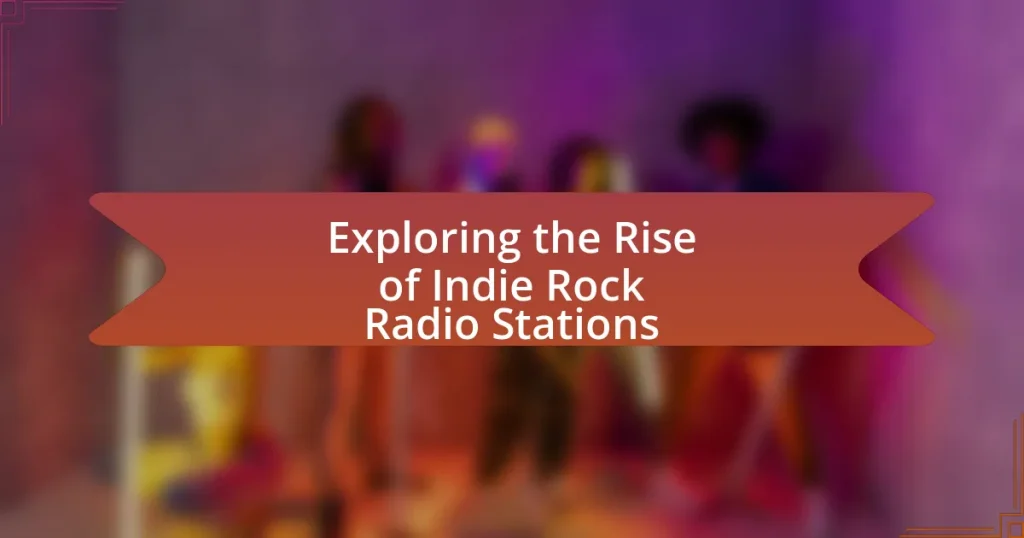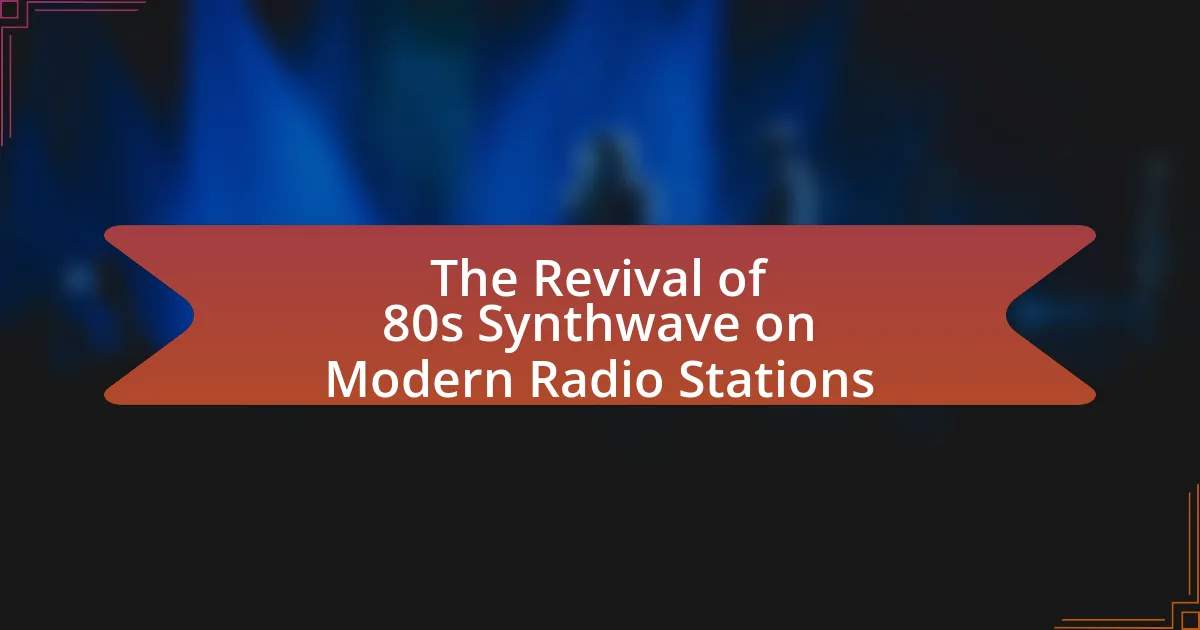Indie rock radio stations are dedicated broadcasting platforms that primarily feature independent rock music, promoting emerging artists and diverse sounds outside of major record labels. The emergence of these stations in the 1990s was driven by the rise of independent music labels and the demand for alternative music, filling a gap left by mainstream radio. Technological advancements, particularly the internet, have further facilitated their growth, allowing for broader access and community engagement. This article explores the historical context, programming styles, challenges, and the vital role these stations play in supporting both artists and listeners within the indie music scene.
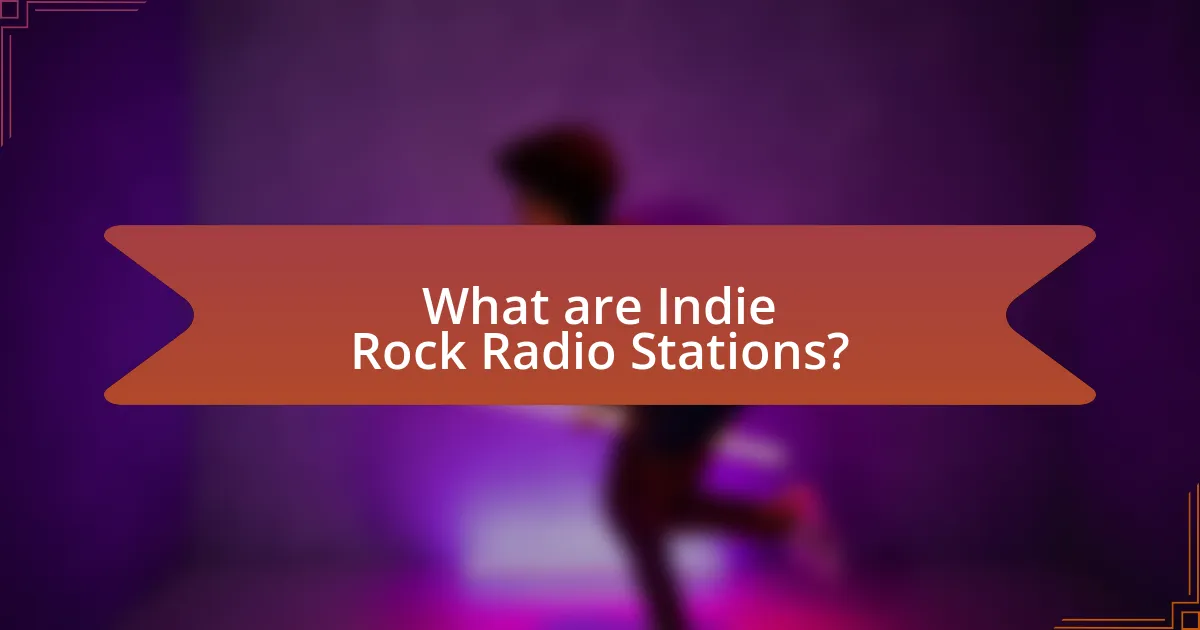
What are Indie Rock Radio Stations?
Indie rock radio stations are broadcasting platforms that primarily focus on playing independent rock music, which is often produced outside of major record labels. These stations promote emerging artists and diverse sounds, contributing to the growth of the indie rock genre. For example, stations like KEXP in Seattle and WXPN in Philadelphia have gained recognition for their commitment to showcasing indie rock talent, often featuring live performances and interviews with artists. This focus on independent music helps to cultivate a community around the genre and supports the broader indie music scene.
How did Indie Rock Radio Stations emerge in the music landscape?
Indie Rock Radio Stations emerged in the music landscape primarily due to the rise of independent music labels and the increasing demand for alternative music in the 1990s. As mainstream radio often overlooked non-commercial artists, these stations filled the gap by providing a platform for indie rock bands, which gained popularity through grassroots movements and college radio. The advent of the internet further accelerated this trend, allowing for online streaming and broader access to diverse music genres, thus solidifying the role of indie rock stations in promoting emerging artists and fostering a dedicated listener base.
What historical events contributed to the rise of Indie Rock Radio Stations?
The rise of Indie Rock Radio Stations was significantly influenced by the emergence of independent music scenes in the 1980s and 1990s, particularly in the United States and the United Kingdom. The punk rock movement, which began in the mid-1970s, laid the groundwork for a DIY ethos that encouraged independent artists to create and distribute their music outside of major record labels. This shift was further propelled by the advent of college radio stations, which began to gain popularity in the 1980s, providing a platform for alternative and indie music that mainstream radio often overlooked. Additionally, the rise of the internet in the late 1990s and early 2000s allowed for greater access to music and the ability for indie artists to reach wider audiences, leading to the establishment of dedicated indie rock radio stations that catered to this growing fanbase.
How have technological advancements influenced the growth of Indie Rock Radio Stations?
Technological advancements have significantly influenced the growth of Indie Rock Radio Stations by enabling easier access to broadcasting and a wider audience reach. The rise of internet streaming platforms has allowed these stations to bypass traditional broadcasting limitations, reaching global audiences without the need for expensive infrastructure. For instance, platforms like SoundCloud and Bandcamp have facilitated the discovery and promotion of indie artists, directly benefiting radio stations that feature their music. Additionally, social media tools have empowered these stations to engage with listeners, build communities, and promote their content effectively, leading to increased listener loyalty and growth. According to a report by the Pew Research Center, 41% of Americans now listen to online radio, highlighting the shift towards digital platforms that support indie music.
What distinguishes Indie Rock Radio Stations from mainstream radio?
Indie Rock Radio Stations are distinguished from mainstream radio by their focus on independent artists and lesser-known music, often prioritizing creativity and diversity over commercial viability. Unlike mainstream radio, which typically features popular, commercially successful tracks, Indie Rock Radio Stations curate playlists that highlight emerging talent and niche genres, fostering a unique listening experience. This approach is supported by the rise of digital platforms and streaming services, which have enabled indie stations to reach audiences seeking alternative music options that are often overlooked by mainstream outlets.
What unique programming styles do Indie Rock Radio Stations adopt?
Indie rock radio stations adopt unique programming styles characterized by a focus on emerging artists, eclectic playlists, and community engagement. These stations often prioritize independent and lesser-known musicians, providing a platform for new talent that mainstream radio typically overlooks. For instance, many indie rock stations feature themed shows that highlight specific genres, local music scenes, or curated playlists that reflect listener preferences, fostering a sense of community and connection among their audience. Additionally, they frequently incorporate listener feedback into their programming decisions, enhancing audience involvement and loyalty. This approach not only differentiates them from commercial stations but also supports the indie music ecosystem by promoting diversity and innovation in music.
How do Indie Rock Radio Stations curate their music selections?
Indie rock radio stations curate their music selections by focusing on emerging artists, independent labels, and a diverse range of sub-genres within indie rock. These stations often rely on music discovery platforms, listener requests, and recommendations from local music communities to identify new tracks. Additionally, many indie rock stations maintain relationships with record labels and artists to receive exclusive releases and promotional materials, ensuring a fresh and varied playlist. This approach not only supports the indie music scene but also fosters a unique listening experience that distinguishes them from mainstream radio.
Why are Indie Rock Radio Stations important for artists and listeners?
Indie Rock Radio Stations are important for artists and listeners because they provide a platform for independent musicians to reach a wider audience while offering listeners access to diverse and unique music. These stations often prioritize emerging artists who may not receive airplay on mainstream radio, thus fostering a vibrant music community. According to a 2021 study by the National Federation of Community Broadcasters, community radio stations, which include many indie rock stations, play a crucial role in promoting local talent, with 70% of surveyed stations featuring local artists regularly. This not only helps artists gain exposure but also enriches the listening experience for audiences seeking fresh sounds outside the commercial music landscape.
How do Indie Rock Radio Stations support emerging artists?
Indie rock radio stations support emerging artists by providing them with airtime to showcase their music, which helps increase their visibility and reach. These stations often prioritize independent and lesser-known artists, creating playlists that feature their tracks alongside more established acts. For instance, according to a study by the Future of Music Coalition, independent radio stations play a significant role in promoting new music, with over 70% of their playlists consisting of tracks from emerging artists. This exposure can lead to increased fan engagement, opportunities for live performances, and potential record deals, thereby fostering the growth of the indie music scene.
What role do Indie Rock Radio Stations play in music discovery for listeners?
Indie Rock Radio Stations play a crucial role in music discovery for listeners by curating and promoting lesser-known artists and tracks that may not receive mainstream attention. These stations often focus on independent labels and emerging talent, providing a platform for diverse sounds and innovative music styles. According to a study by the Pew Research Center, 49% of listeners discover new music through radio, highlighting the importance of radio as a medium for music exploration. By featuring a mix of genres and local talent, Indie Rock Radio Stations foster a community of music enthusiasts who are eager to explore new sounds, thus enhancing the overall music discovery experience.
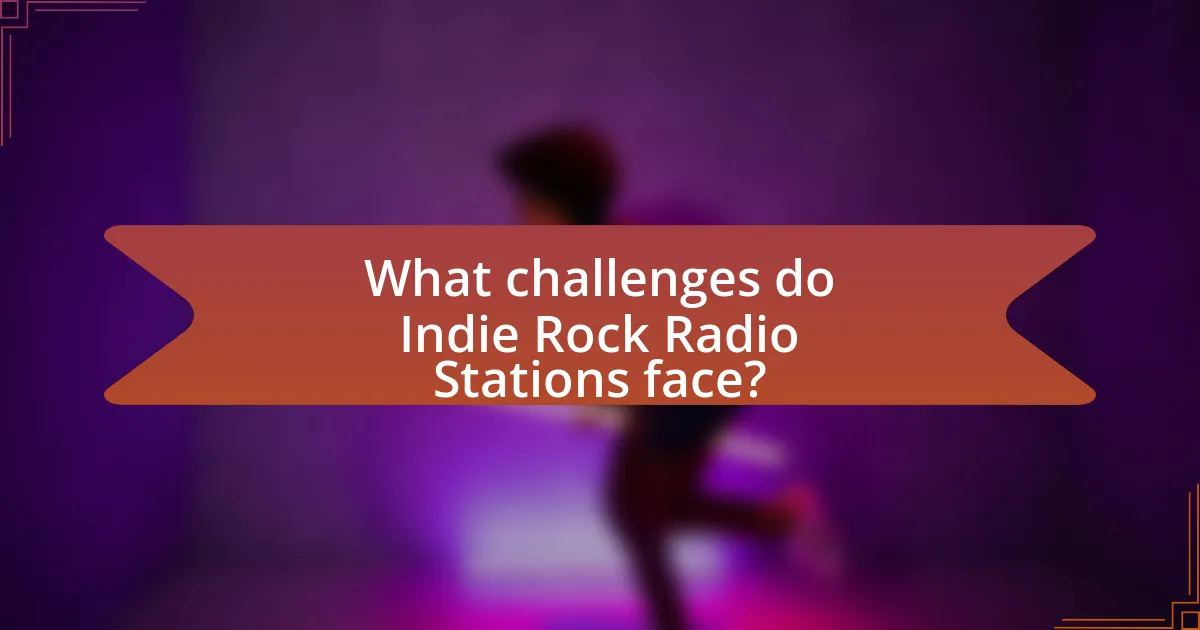
What challenges do Indie Rock Radio Stations face?
Indie rock radio stations face significant challenges, primarily due to competition from digital streaming platforms. These platforms, such as Spotify and Apple Music, dominate music consumption, leading to decreased listener numbers for traditional radio. According to a 2022 report by the Pew Research Center, 61% of U.S. adults now prefer streaming services over radio for music, highlighting the shift in audience preferences. Additionally, indie rock radio stations often struggle with limited funding and resources, which restricts their ability to promote new artists and maintain operational costs. This financial strain is compounded by the need to secure advertising revenue, which has been declining as advertisers shift their focus to digital media.
How do financial constraints impact Indie Rock Radio Stations?
Financial constraints significantly limit the operational capabilities of Indie Rock Radio Stations. These stations often rely on limited funding sources, such as listener donations, small advertising revenues, and grants, which can restrict their ability to invest in quality programming, marketing, and technology. For instance, a study by the Pew Research Center in 2020 indicated that nearly 60% of small radio stations reported financial difficulties, impacting their ability to hire staff and maintain equipment. Consequently, these financial limitations can lead to reduced airplay for emerging artists, limiting the diversity and reach of Indie Rock music within the community.
What funding models are commonly used by Indie Rock Radio Stations?
Indie Rock Radio Stations commonly utilize funding models such as listener donations, sponsorships, and grants. Listener donations often form the backbone of funding, with stations like WFMU relying heavily on their audience for financial support during fundraising drives. Sponsorships from local businesses provide additional revenue, allowing stations to promote community engagement while generating income. Furthermore, grants from arts organizations and non-profits, such as the Corporation for Public Broadcasting, offer financial assistance aimed at supporting independent media initiatives. These models collectively enable Indie Rock Radio Stations to operate and promote diverse music content.
How do advertising and sponsorship affect programming choices?
Advertising and sponsorship significantly influence programming choices by dictating content that aligns with the interests of advertisers and sponsors. Radio stations, particularly indie rock stations, often curate their playlists and programming schedules to attract specific demographics that appeal to potential sponsors, thereby maximizing advertising revenue. For instance, a study by the Pew Research Center found that 63% of radio stations adjust their programming based on advertiser preferences, which directly impacts the selection of music genres, featured artists, and even talk segments. This alignment ensures that the content resonates with both the audience and the financial backers, ultimately shaping the overall listening experience.
What competition do Indie Rock Radio Stations encounter?
Indie Rock Radio Stations encounter competition from mainstream radio stations, streaming services, and podcast platforms. Mainstream radio stations often dominate the airwaves with popular music, limiting the exposure of indie rock artists. Streaming services like Spotify and Apple Music provide listeners with personalized playlists and vast music libraries, making it easier for users to discover new music without relying on radio. Additionally, podcast platforms offer alternative audio content that can attract the same audience, further fragmenting listener attention. These factors collectively challenge the reach and sustainability of indie rock radio stations in a rapidly evolving media landscape.
How do streaming services challenge the relevance of Indie Rock Radio Stations?
Streaming services challenge the relevance of Indie Rock Radio Stations by providing listeners with on-demand access to a vast library of music, including niche indie rock tracks that may not be featured on traditional radio. This accessibility allows users to curate personalized playlists and discover new artists without the limitations of a radio station’s programming schedule. According to a 2021 report by the Recording Industry Association of America, streaming accounted for 83% of the U.S. music industry’s revenue, highlighting its dominance over traditional radio. As a result, Indie Rock Radio Stations struggle to compete for audience attention and advertising revenue, leading to a decline in their influence and relevance in the music landscape.
What strategies do Indie Rock Radio Stations employ to retain listeners?
Indie Rock Radio Stations employ several strategies to retain listeners, including curating unique playlists, engaging with local music scenes, and fostering community interaction. By offering a diverse selection of lesser-known tracks and emerging artists, these stations differentiate themselves from mainstream radio, attracting listeners seeking fresh sounds. Additionally, many stations collaborate with local venues and artists to host live events, creating a sense of community and loyalty among listeners. Interactive elements, such as listener polls and social media engagement, further enhance listener involvement and investment in the station’s programming. These strategies collectively contribute to listener retention by creating a distinctive and participatory listening experience.
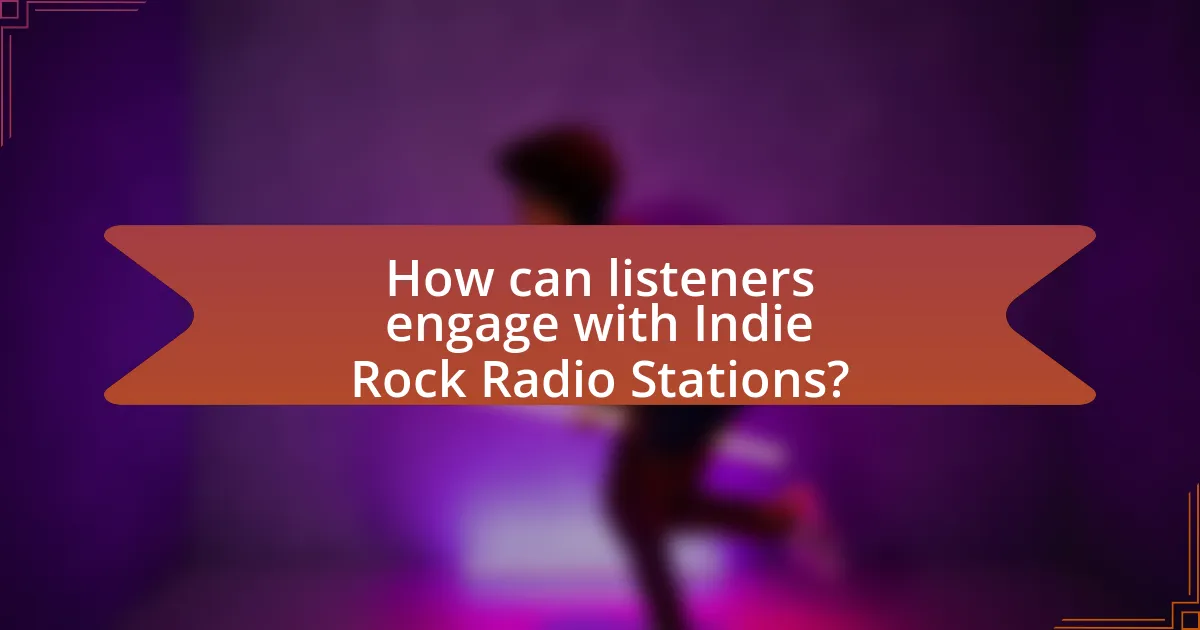
How can listeners engage with Indie Rock Radio Stations?
Listeners can engage with Indie Rock Radio Stations by tuning in through various platforms such as FM/AM radio, online streaming services, and mobile apps. These platforms allow listeners to access a diverse range of indie rock music, discover new artists, and participate in live shows. Additionally, listeners can interact by calling in during broadcasts, participating in social media discussions, and providing feedback through station websites or apps. This engagement fosters a community around indie rock music, enhancing the listener experience and supporting independent artists.
What are the best ways to discover new music through Indie Rock Radio Stations?
The best ways to discover new music through Indie Rock Radio Stations include tuning into curated playlists, engaging with station-hosted events, and utilizing online streaming platforms. Curated playlists often feature emerging artists and tracks that align with the station’s unique sound, providing listeners with a tailored experience. Additionally, many Indie Rock Radio Stations host live events or showcases, allowing fans to experience new music firsthand and interact with artists. Online streaming platforms often archive past shows, enabling listeners to explore a wider range of music at their convenience. These methods are effective because they connect listeners directly with the Indie Rock community and promote lesser-known artists, fostering a deeper appreciation for the genre.
How can listeners participate in station events or promotions?
Listeners can participate in station events or promotions by engaging through social media platforms, attending live events, and entering contests hosted by the station. Many indie rock radio stations actively promote their events on platforms like Facebook, Instagram, and Twitter, where listeners can find information about upcoming shows and promotions. Additionally, stations often host live events such as concerts or meet-and-greets, providing opportunities for listeners to connect with artists and other fans. Contests, which may include giveaways or ticket raffles, are frequently advertised on-air and online, allowing listeners to win prizes by following specific entry guidelines.
What platforms can listeners use to access Indie Rock Radio Stations online?
Listeners can access Indie Rock Radio Stations online through platforms such as TuneIn, iHeartRadio, and Radio Garden. These platforms aggregate numerous radio stations, including those dedicated to indie rock, allowing users to stream content easily. For instance, TuneIn offers a wide variety of indie rock stations and has millions of active users, demonstrating its popularity as a streaming service. Similarly, iHeartRadio provides access to both live and on-demand indie rock content, further solidifying its role in the indie music scene. Radio Garden allows users to explore radio stations from around the world, including indie rock stations, by navigating an interactive globe, showcasing the global reach of indie music.
What tips can enhance the experience of listening to Indie Rock Radio Stations?
To enhance the experience of listening to Indie Rock Radio Stations, listeners should curate personalized playlists that include their favorite tracks and artists featured on the station. This approach allows for a deeper connection to the music, as listeners can explore similar sounds and styles. Additionally, engaging with the station’s community through social media or forums can provide insights into upcoming artists and events, enriching the overall experience. Research indicates that active participation in music communities can lead to increased satisfaction and discovery of new music, as highlighted in studies on listener engagement in radio broadcasting.
How can listeners create personalized playlists based on Indie Rock Radio Station recommendations?
Listeners can create personalized playlists based on Indie Rock Radio Station recommendations by utilizing music streaming platforms that allow for playlist creation and curation. These platforms often feature algorithms that analyze listener preferences and suggest songs played on Indie Rock stations, enabling users to compile tracks that align with their tastes. For instance, services like Spotify and Apple Music provide features where users can follow Indie Rock stations, receive song recommendations, and easily add those tracks to their own playlists. This method leverages the popularity of Indie Rock tracks and the data-driven insights of streaming services to enhance the personalization of music collections.
What are some common misconceptions about Indie Rock Radio Stations that listeners should be aware of?
Common misconceptions about Indie Rock Radio Stations include the belief that they only play obscure music and lack professional quality. In reality, many Indie Rock Radio Stations curate a diverse range of music, including well-known indie artists, and often feature high production values comparable to mainstream stations. Additionally, listeners may think that these stations are solely focused on local talent; however, many have a global reach and showcase international indie music. Furthermore, some assume that Indie Rock Radio Stations do not have a dedicated audience, but studies indicate that indie music has a significant and growing listener base, with platforms like Spotify reporting millions of streams for indie tracks.
